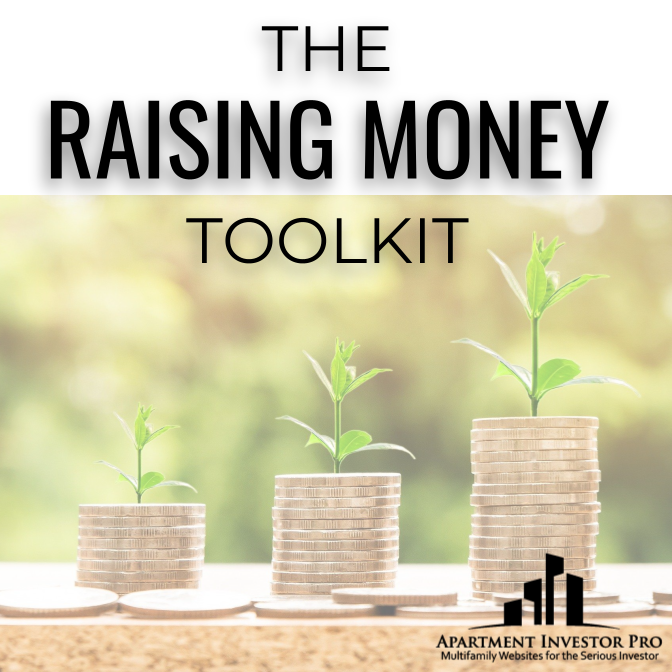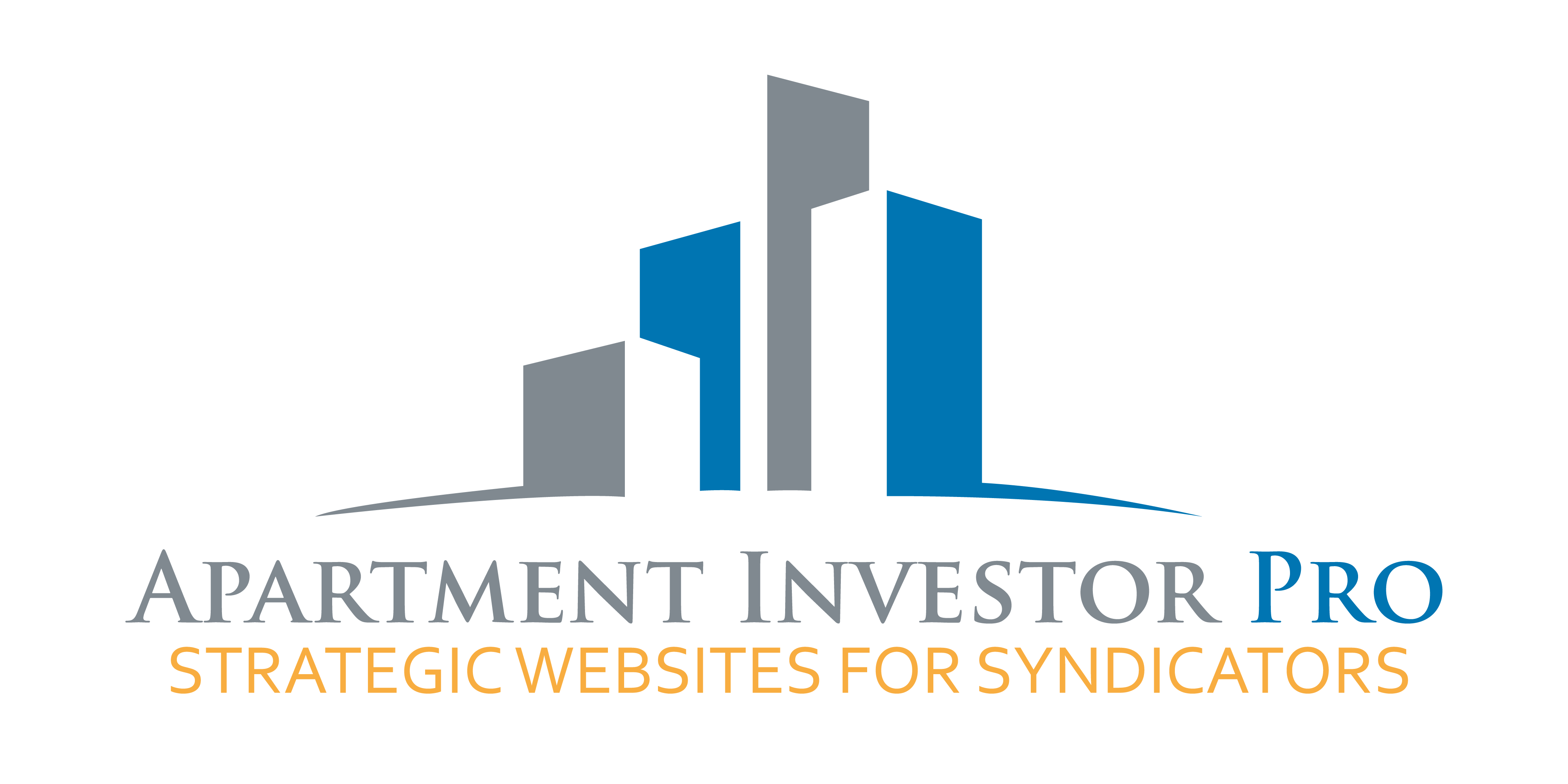How to raise money for multi-family property investing is one of the biggest concerns for multifamily investors / syndicators.
Whether you’re just getting started and need to raise money without having a track record, or if you’ve done some deals but have tapped out your personal network, this article will help.
Here’s a quick overview:
- A case study of how one investor raised $1 million in 2 weeks
- A video interview where Adam Adams, who has raised millions of dollars from private investors, shares tips for how to get investors before you have a deal, and how to raise money after you’ve tapped out your personal network
- You’ll have an opportunity to get our “Raising Money Toolkit” for FREE
- We’ll share 4 ways to raise money that you can start doing today
- Plus additional tips and resources to successfully raise the money you need
Let’s get started!
Case Study: How One Investor Raised 1 Million Dollars in 2 Weeks to Finance His First Multifamily Deal
Dave Thompson, who has helped provide investor funds to purchase over 4,500 apartment units worth over $400M, raised a million dollars for his first multifamily syndication deal. Then, within just one year, he raised close to $9 million to help acquire 5 large apartment communities.
What If This Were You?
- He raised a million dollars for his first multifamily syndication.
- For the first deal he found 13 investors, averaging about $75,000 per investor.
- He raised 1 million dollars in just 2 weeks!
A total of 13 investors… 13 is not a huge number. Even if your personal network is not very big, this number of investors is definitely within your reach.
Another interesting point: Dave didn’t ask for many referrals on his first deal. He admits that this was a mistake. This is something he only did effectively when raising capital for his second deal. You should ask for referrals from your network right from the beginning.
How Did He Raise The Money For His First Deal?
- Step 1 – He Leveraged His Personal Network (family, friends and work colleagues)
- Step 2 – He Built Relationships Through Online Investing Community BiggerPockets
- Step 3 – He Attended Local Multifamily Meet-ups (5% of investment came through meet-ups)
Money Raising Breakdown
- Personal Network = 70% (Wife’s network = 35%, one past business associate = 35%)
- BiggerPockets = 25%
- Local Multifamily Meet-ups = 5%
The majority of Dave’s investment dollars came from two sources.
Let’s dig in deeper on these 2 sources that produced 95% of the investment dollars.
Personal Network
Dave’s personal network includes family, friends, and work colleagues.
Likely some of your connections also know you as an individual with drive and determination. The people close to you probably already have more confidence in you than you think.
When Dave started digging he discovered he knew many people that were already interested in real estate and had cash readily available.
A past business associate from the high-tech sector ended up being Dave’s biggest contributor.
If you have connections who work in the field of high-tech, legal, or medical, this is a gold mine for raising money. Many professionals don’t have time to be actively involved with RE and they are crying out for someone to put their money to work for them. You will be doing them a huge service by helping them to get better returns on their investment dollars.
The way Dave went about building relationships with these investors was inspirationally simple.
He would host a BBQ and gently mention what he was getting into. If there was a spark of interest he would email them and set up an appointment to specifically talk about the deal.
BiggerPockets
BiggerPockets was another network that Dave leveraged to raise money. BiggerPockets attracts investors who are actively looking for opportunities.
Yes, the online opportunity is enormous. There is a massive community of investors out there waiting to connect with you. The BiggerPockets platform can lead you to them.
While Dave couldn’t specifically advertise his deals, he posted valuable content and created a strong bio page. People looked at his profile and saw that he was involved with syndication, then they would approach him.
So concentrate on putting together a good bio page on BiggerPockets and providing valuable information in the forums. When you show your expertise in the forum discussions this gives people a reason to look at your bio, reach out to you, and connect with you. Do these two things and your online network will really come alive.
This example is one of thousands of success stories that teach us that the obstacles between you and the investment dollars you need may not be that great.
With a little ambition and belief you can rise to the challenge of finding those investment dollars. When you do, you will be on your way to fulfilling your financial dreams.
But how can you keep raising capital if you’ve already tapped out your personal network?
Here is my conversation with multifamily investor and host of the Creative Real Estate Podcast, Adam Adams. In this video interview you’ll get clear answers to that question and loads more:
Question #1: How do you get commitments from investors before the deal is even lined up?
Question #2: Why is it actually better to start investing with larger units?
Question #3: What if I’m uncomfortable with asking people to invest their money?
Click below to watch the interview and learn how to start raising money the right way.

Get the free “Raising Money Toolkit”
Includes:
10 Places You Hadn’t Thought To Find Passive Investors
Sample deal template
How to connect with 10,000 accredited investors on LinkedIn
4 Ways on How to Raise Money for Multi-family Property Investing:
1. Your Personal Network
Approaching friends and family may seem like a last resort as it’s no great revelation to say that many relationships have been put under a lot of strain due to business dealings.
The way to ensure that the relationship stays healthy and positive is to make sure that communication is clear and that everything is down in writing.
This isn’t a question of trust but it is an essential step because it prevents misunderstandings.
Make sure that all agreements even with family and friends are written up and signed properly, thus protecting all parties and guarding against any potential ill-feeling down the road.
Your friends, family, neighbors, and co-workers trust you because of the ethics that they have observed in you over the years.
2. Social Media
Use social media such as LinkedIn, Facebook and BiggerPockets to expand your network and meet new investors. Follow Dave’s example in the Case Study above.
3. Networking and Events
Attending live events or meetups is a great way to meet new people who could be potential investors for your deals. Check out upcoming multifamily investing events here.
4. Be a Thought Leader
To greatly extend your network you need to fully embrace digital marketing.
Position yourself as a thought leader in the real estate investing world by producing lots of valuable content across multiple platforms using different mediums such as podcasts, blogging, videos, etc.
Have a way to capture those leads once they start coming in. If you are directing people to your website, make sure that you have a lead capture form and offer something of value in exchange for that potential investor’s email address.
Just be sure that when you get new contacts that you reach out and start to build the relationship by means of more engaging content.
Additional Tips for Raising Money
Tip 1: Focus on relationships, not the money.
Experienced investors speak about the danger of looking at every contact and connection in your network as a dollar sign.
You need to give people the chance to build a relationship with you and to build trust.
The best way is to speak with people in your network with enthusiasm about the deals you have done (if you’ve done some) any deals you’re working on now, or upcoming deals. When they respond with enthusiasm you can take it from there.
Attracting passive investors is not just about making connections. You may attend an event and make a lot of connections and gather a lot of business cards but the important thing is to follow up and build on that initial contact before the connection grows cold.
Tip 2: What to say
In your conversations with investors, your objective is twofold.
Your first objective is to increase their confidence in you and your deal.
Your second objective is to see if the investor is right for you.
Explain to them that you are in this together with them and if you have money invested you can tell them that you also have ‘skin in the game.’
Even if you are not investing your own money in the deal for whatever reason, you can still reassure them of your 100% commitment.
You can talk about your track record with potential investors and if your track record is not so convincing then you can speak about the track record of your partner and that of your team.
Ask them questions about what they invested in before and what they liked and disliked about the way that investment worked out for them.
Some investors will be happy to wait patiently for returns and others have different expectations. It’s good to find out about what type of investor you are dealing with.
If you have your investors’ best interests at heart and ensure that the deal is right for them, then you will also be saving yourself a lot of headaches later on.
Just because someone has the money and wants to invest with you doesn’t mean they’re a good fit.
Now, if you got this right, it’s time for you to learn How To Find Off-Market Multifamily Deals.

Get the free “Raising Money Toolkit”
Includes:
10 Places You Hadn’t Thought To Find Passive Investors
Sample deal template
How to connect with 10,000 accredited investors on LinkedIn
Where to Start
Many of these tools and tips can only work for you if you have a hub for all your online marketing activity. That hub is your website.
It’s important to ask yourself:
Is my website representing me in the right way?
Does it inspire confidence in investors that need to be convinced of my professionalism?
Does it have a method for capturing the contact information of potential investors that visit the site so that I can quickly follow up on the interest?
For more information about how we can help you to overcome these obstacles and more, check out our website service for multifamily investors at ApartmentInvestorPro.com
